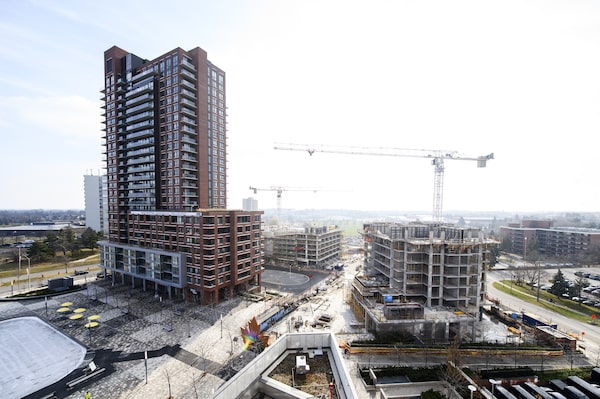
Condo construction in Ajax, Ont., on Nov. 30, 2023.Christopher Katsarov/The Canadian Press
Jonathan Diamond is a principal at Well Grounded Real Estate.
Toronto saw an enormous proliferation of apartment development in the 1950s and 1960s. However, since then, we have developed very little purpose-built rental housing, with condo construction representing the bulk of new multiunit product. This shift in the market, together with our population growth, has resulted in the current rental crises.
Increasing overall supply – to build, build, build, as proponents say – is a straightforward solution; however, building enough units to achieve price stability is challenging, especially given the inability of our current housing delivery models to scale. Alternatively, addressing the financial barriers of developing purpose-built rentals could yield immediate affordability, avoiding the long-term challenges of supply interventions.
To explain why, it is important to recognize that high market rents on new purpose-built rentals are only a small sample of the rental population. This can be viewed as a survivorship bias because the rental buildings that do get built are those that are economically viable.
In other words, there is a large mid-market waiting to be served by developers of rental units, but because of the financial challenges of such projects, they are nearly impossible to make work.
Thus, to achieve affordability today, private industry and government must collaborate on strategies to significantly reduce the cost of projects to make lower-rent purpose-built rentals economically feasible. For instance, the recent removal of GST/HST on rental construction is one example of how government has helped make rental projects more affordable.
But governments can do more. On the government side, numerous fees are billed to developers that significantly escalate costs. These include development charges ($33,497-$48,299 per unit), community benefit fees, application fees, separate school board education charges, parkland fees, and slow application processing times that extend land-carrying costs and increase project risk with approval uncertainty. These fees can be up to 10 per cent of the project cost.
Lowering these costs will have a significant impact because it makes purpose-built rental projects easier for developers to finance. For reference, the equity in any residential development – the amount the developer must contribute – may be a small portion of the total project costs. For condos, it’s around 15 per cent, with the remaining 85 per cent coming largely from presales and a construction loan that is repaid by way of the sale of condo units.
In contrast, the rental apartment developer doesn’t sell the units, so there are no presales. On top of that, there is no exit event to repay the construction loan. Instead, the short-term construction loan is repaid by an amortized loan, a term loan, which is based on the building’s rental revenue: the higher the revenue, the higher the term loan. This is analogous to how the size of a personal mortgage is driven by the income of the borrower.
This means that, for a rental developer to put up a comparable amount of equity as a condo developer, the building would need to support high rents. By my firm’s calculations, for a 100-unit rental project in the GTA that targeted equity of 15 per cent of the total cost (similar to a condo), the average rents per unit would need to be $3,770, much higher than today’s going rates.
As a reference point, the average rent in Toronto for bachelor, one-bedroom, two-bedroom and three-bedroom apartments is $1,427, $1,708, $1,992 and $2,241, respectively. To build to this market, the developer would need to contribute 58 per cent of the project cost as equity, an amount that no developer would invest. This project would never get off the ground, underscoring the reason why such projects don’t get built.
Reducing project costs would enable new rental buildings to serve a wider range of renters. Development teams are crucial in this effort by advancing innovative design and delivery strategies that promote cost reductions. On the government side, it is essential to recognize that substantial fees, such as development charges, and taxes pose a significant barrier to delivering more affordable rental housing. Such levies must be reduced before governments layer on incentives that simply compensate for high development costs.
Over all, reducing the costs of rental development will lower the equity demands of these projects, making them viable in underserved rental markets that currently cannot support their construction. I am optimistic that such initiatives will unlock a massive mid-market that can be economically viable for long-term rental developers, such as ourselves and others, making Toronto more affordable today.